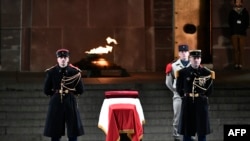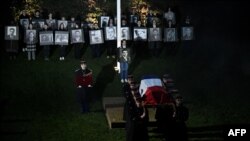The remains of stateless Armenian poet and fighter Missak Manouchian and his wife Melinee are being moved to the country's Pantheon mausoleum of national heroes during a state ceremony on Wednesday.
It is the first time that any foreign communist member of the French Resistance is being honoured in such a way despite many of them taking part in the underground battle against the Germans.
A plaque to be unveiled inside the crypt will honor 23 other foreign communist members of the Resistance — including Polish, Hungarian, Italian, Spanish and Romanian fighters -- who were rounded up and sentenced to death.
"The mistake has been corrected and now all the Resistance is fully represented at the Pantheon," said 82-year-old Georges Duffau-Epstein, whose Jewish immigrant father Joseph Epstein will be honoured with a mention.
"It's such a joy. It's as if my father's remains were being taken to the Pantheon."
Economic, political migrants
Many foreigners played key Resistance roles in the 1939-45 war.
They were mostly "anti-Nazi Germans and Austrians, Spanish Republicans who had fled Francoism, anti-fascist Italians, Poles who had fled anti-Semitism, Armenians, and Jews from eastern Europe and Germany," according to the French defence ministry.
Some 2.2 million foreigners lived in France at the time, it says.
Many had come to work after World War I, then later fleeing anti-Communist or anti-Semitic persecutions in the rest of Europe, historian Denis Peschanski told AFP.
It was unclear how many exactly joined the Resistance, he said.
But of the 1,000 Resistance fighters executed by the Nazis at the Mont-Valerien fort outside Paris during the occupation, 185 were foreign, he said.
That was a much higher proportion than of foreigners in the country's pre-war population of some 40 million.
'Kids' and fighters
Foreign resistance took on several forms, Peschanski said.
Thousands of Spaniards organised independently in the southwest of the country, while Italians banded together in the southeast.
Others in urban areas like Manouchian joined the foreign branch of the communist armed Resistance, called the Irregulars and Partisans — Immigrant Workers (FTP—MOI), he said.
The FTP—MOI included two types of members, according to the historian.
There were "kids" aged 17 to 22 who had been raised in politicised immigrant families, and members of a slightly older generation aged 32 to 35 who had experienced repression in eastern Europe, Italy or Germany, or had fought on the Republican side during the 1936-39 Spanish Civil War.
Colonel assassination
Manouchian came to France as a young man in the mid-1920s, after fleeing the World-War-I-era mass killings of Armenians in the Ottoman Empire as a child to French-mandate Lebanon.
After the Nazis occupied Paris in 1940, he distributed tracts against the German occupation.
He joined the French communist party's armed resistance in 1943, soon leading dozens of immigrant workers fighting the German occupiers in the Paris region.
Other Armenians also joined.
Under his watch they carried out sabotage actions, train derailings and attacked German soldiers and assassinated a German SS colonel.
Manouchian was arrested in November 1943 and tortured, before being sentenced to death with 22 of fellow fighters.
He was shot dead by firing squad aged 37 with 21 others in February 1944 at Mont-Valerien. A Jewish woman from Bessarabia, now Moldova, in the same group called Golda Bancic was beheaded by guillotine in Germany.
In April of the same year, Epstein too was shot dead.
Their 23 names will feature on the plaque inside the Pantheon.
Finally'
Among them is Spanish immigrant Celestino Alfonso.
He fought on the Republican side during the Spanish Civil War, then joined the French Resistance.
Under Manouchian, he was part of a team of three tasked with assassinating the SS colonel. They learned later the Nazi official had been in charge of the forced enlistment of French workers.
His granddaughter Juana Alfonso, 57, told AFP she was delighted he was "finally receiving recognition."
But "I'm sad my father never got to see this," she said.
He had never recovered from his father's execution, she explained, and had died of a broken heart aged 33.












Forum